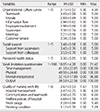Abstract
Purpose
The purpose of this study was to construct and test a structural equation model of quality of work life for clinical nurses based on Peterson and Wilson's Culture-Work-Health model (CWHM).
Methods
A structured questionnaire was completed by 523 clinical nurses to analyze the relationships between concepts of CWHM-organizational culture, social support, employee health, organizational health, and quality of work life. Among these conceptual variables of CWHM, employee health was measured by perceived health status, and organizational health was measured by presenteeism. SPSS21.0 and AMOS 21.0 programs were used to analyze the efficiency of the hypothesized model and calculate the direct and indirect effects of factors affecting quality of work life among clinical nurses.
Results
The goodness-of-fit statistics of the final modified hypothetical model are as follows: χ2=586.03, χ2/df=4.19, GFI=.89, AGFI=.85, CFI=.91, TLI=.90, NFI=.89, and RMSEA=.08. The results revealed that organizational culture, social support, organizational health, and employee health accounted for 69% of clinical nurses' quality of work life.
Conclusion
The major findings of this study indicate that it is essential to create a positive organizational culture and provide adequate organizational support to maintain a balance between the health of clinical nurses and the organization. Further repeated and expanded studies are needed to explore the multidimensional aspects of clinical nurses' quality of work life in Korea, including various factors, such as work environment, work stress, and burnout.
References
1. Kim HG, Ok SY. Conceptualization, development and validation of an organizational well-being scale. J Hum Resour Manag Res. 2010; 17(4):325–348.
2. Brooks BA, Anderson MA. Defining quality of nursing work life. Nurs Econ. 2005; 23(6):319–326.
3. Richard J, Suttle LJ. Improving life at work: Behavioural science approaches to organizational change. Santa Monica, CA: Goodyear Publishing Co.;1977.
4. Kwon M, Kim SL. The job stress and presenteeism of occupational health nurses in workplace in Korea. Korean J Occup Health Nurs. 2010; 19(2):159–169.
5. Johns G. Presenteeism in the workplace: A review and research agenda. J Organ Behav. 2009; 31(4):519–542. DOI: 10.1002/job.630.
6. Kim M, Choi HO, Ryu E. Predictors of clinical nurses' presenteeism. Korean J Occup Health Nurs. 2014; 23(3):134–145. DOI: 10.5807/kjohn.2014.23.3.134.
7. Davey MM, Cummings G, Newburn-Cook CV, Lo EA. Predictors of nurse absenteeism in hospitals: A systematic review. J Nurs Manag. 2009; 17(3):312–330. DOI: 10.1111/j.1365-2834.2008.00958.x.
8. Kessler RC, Ames M, Hymel PA, Loeppke R, McKenas DK, Richling DE, et al. Using the World Health Organization Health and Work Performance Questionnaire (HPQ) to evaluate the indirect workplace costs of illness. J Occup Environ Med. 2004; 46:6 Suppl. S23–S37. DOI: 10.1097/01.jom.0000126683.75201.c5.
9. Peterson M, Wilson JF. The culture-work-health model and work stress. Am J Health Behav. 2002; 26(1):16–24. DOI: 10.5993/AJHB.26.1.2.
10. An JY, Yom YH, Ruggiero JS. Organizational culture, quality of work life, and organizational effectiveness in Korean university hospitals. J Transcult Nurs. 2011; 22(1):22–30. DOI: 10.1177/1043659609360849.
11. Gifford BD, Zammuto RF, Goodman EA. The relationship between hospital unit culture and nurses' quality of work life. J Healthc Manag. 2002; 47(1):13–25. discussion 25-26
12. Hsu MY, Kernohan G. Dimensions of hospital nurses' quality of working life. J Adv Nurs. 2006; 54(1):120–131. DOI: 10.1111/j.1365-2648.2006.03788.x.
13. Argentero P, Miglioretti M, Angilletta C. Quality of work life in a cohort of Italian health workers. G Ital Med Lav Ergon. 2007; 29:1 Suppl A. A50–A54.
14. Kellar SP, Kelvin E. Munro's statistical methods for health care research. 6th ed. Philadelphia, PA: Wolters Kluwer Health/Lippincott Williams & Wilkins;2012.
15. Glaser SR, Zamanou S, Hacker K. Measuring and interpreting organizational culture. Manag Commun Q. 1987; 1(2):173–198. DOI: 10.1177/0893318987001002003.
16. Kim M. Structural equation modeling of quality of work life in clinical nurse based on the culture-work-health model [dissertation]. Seoul: Chung Ang University;2015.
17. Cobb S. Presidential Address-1976. Social support as a moderator of life stress. Psychosom Med. 1976; 38(5):300–314. DOI: 10.1097/00006842-197609000-00003.
18. O'Driscoll MP, Brough P, Kalliath TJ. Work/family conflict, psychological well-being, satisfaction and social support: A longitudinal study in New Zealand. Equal Oppor Int. 2004; 23(1-2):36–56. DOI: 10.1108/02610150410787846.
19. Lerner D, Amick BC, 3rd , Rogers WH, Malspeis S, Bungay K, Cynn D. The work limitations questionnaire. Med Care. 2001; 39(1):72–85. DOI: 10.1097/00005650-200101000-00009.
20. Ware JE Jr. Scales for measuring general health perceptions. Health Serv Res. 1976; 11(4):396–415.
21. Yu JP. The concept and understanding of structural equation modeling. Seoul: Hannare Publishing Co.;2012.
22. Dogbey EA. The relationships among unit culture, work stress, compassion fatigue and sense of wellbeing in operating room nurses in level one or two trauma centers [dissertation]. Chester, PA: Widener University School of Nursing;2008.
23. Baker-McClearn D, Greasley K, Dale J, Griffith F. Absence man agement and presenteeism: The pressures on employees to attend work and the impact of attendance on performance. Hum Resour Manag J. 2009; 20(3):311. 328. DOI: 10.1111/j.1748-8583.2009.00118.x.
24. Yom YH, Noh SM, Kim KH, Ji SJ, Kim HJ. Development of the evaluation indicators of positive nursing organizational culture in a clinical setting. J Korean Clin Nurs Res. 2013; 19(2):233–244.
25. Dolan SL, García S, Cabezas C, Tzafrir SS. Predictors of "quality of work" and "poor health" among primary health-care personnel in Catalonia: Evidence based on cross-sectional, retrospective and longitudinal design. Int J Health Care Qual Assur. 2008; 21(2):203–218. DOI: 10.1108/09526860810859058.
26. Shin KR, Cho MO, Kim JS. The meaning of death as experienced by elderly women of a Korean clan. Qual Health Res. 2005; 15(1):5–18. DOI: 10.1177/1049732304270758.
27. You S. Comparisons of the nursing workforce with Japan, and the U.S. J Digit Converg. 2013; 11(6):275–287.
28. Lee YW, Dai YT, Park CG, McCreary LL. Predicting quality of work life on nurses' intention to leave. J Nurs Scholarsh. 2013; 45(2):160–168. DOI: 10.1111/jnu.12017.




 PDF
PDF ePub
ePub Citation
Citation Print
Print







 XML Download
XML Download